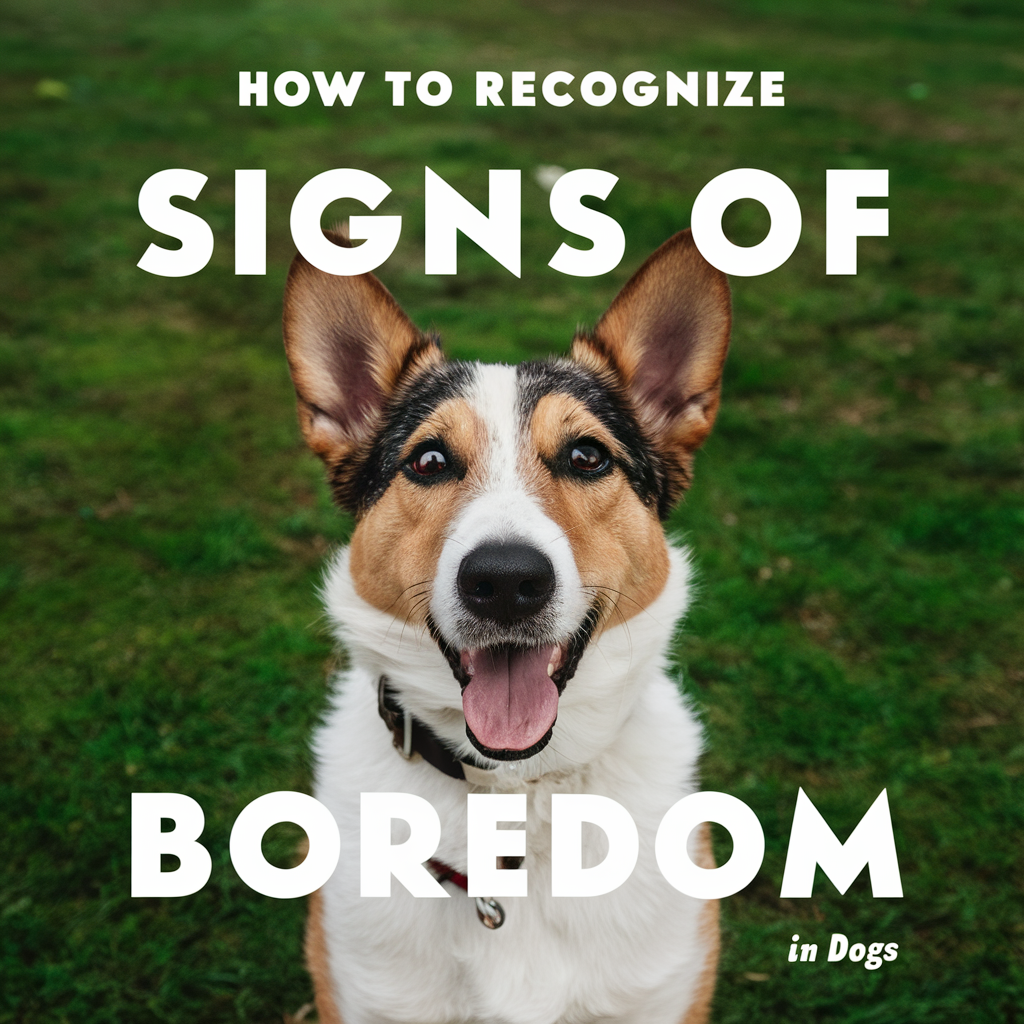
Why Understanding Boredom in Dogs is Important
As dog owners, we often think that as long as our pets are fed, walked, and loved, they’ll be perfectly content. But just like people, dogs can experience boredom, and when they do, it can lead to a range of behavioral problems. I learned this firsthand with my own dog, who started showing signs of restlessness and destruction around the house. At first, I didn’t connect the dots, but once I realized he was bored, everything started to make sense.
Understanding the signs of boredom in dogs is crucial because it allows us to address the issue before it leads to more serious problems like anxiety or destructive behavior. Boredom can affect all dogs, regardless of age or breed, and keeping them mentally and physically engaged is key to preventing frustration. And the best part? There are plenty of simple solutions—many of which involve using the right toys and activities to keep your dog entertained and engaged.
If you’re noticing that your dog may be getting bored, investing in the right toys can make a huge difference. These toys are designed to keep your dog mentally stimulated and happy. For great toy options, check out the 6 Best Toys to Combat Boredom in Dogs here.

Common Signs of Boredom in Dogs
Dogs can’t exactly tell us when they’re bored, but they sure know how to show it through their behavior. After I realized my dog was bored, I started to notice a range of common signs that had been there all along. Here are some of the most typical behaviors that signal a bored dog:
1. Excessive Barking
When a dog is bored, they might bark at just about anything—neighbors, passing cars, or even at nothing at all. This is their way of seeking attention or expressing frustration. If your dog seems to be barking more than usual, boredom could be the reason.
2. Chewing and Destructive Behavior
Chewed-up shoes, furniture, or random household items? It’s not just about teething or curiosity—this could be your dog’s way of dealing with pent-up energy. Dogs need something to focus on, and if they don’t have toys or activities to keep them occupied, they’ll create their own entertainment (often at your home’s expense).
3. Restlessness or Pacing
Restless behavior, such as pacing back and forth or constantly moving around, can be a sign that your dog is bored. They simply don’t know what to do with themselves and are looking for something to engage their mind or body.
4. Excessive Licking or Grooming
A bored dog might start excessively licking or grooming themselves, sometimes to the point of creating sores. This can be a sign of both boredom and frustration, and it’s important to recognize it early on.
5. Digging
Whether they’re outside digging holes in the yard or clawing at the carpet indoors, a dog that is bored may channel their energy into digging. This is especially common in high-energy breeds or dogs that are left alone for long periods.
If you notice any of these behaviors, it’s a good indication that your dog might need more mental stimulation. One of the easiest ways to combat boredom is by providing engaging toys that challenge your dog and keep them occupied. For some of the best toys designed to fight dog boredom, take a look at the 6 Best Toys to Combat Boredom in Dogs here.

The Link Between Boredom and Behavioral Problems
When dogs are bored for extended periods, it doesn’t just result in chewed-up shoes or restless pacing—it can lead to much more serious behavioral problems. Boredom creates frustration, and frustrated dogs often develop habits that are difficult to break if left unchecked.
Long-Term Effects of Boredom
If a dog’s boredom isn’t addressed, they can start showing signs of separation anxiety, becoming overly attached to their owners or excessively clingy. In some cases, bored dogs can become destructive when left alone, not just chewing on things but tearing up furniture, doors, or even attempting to escape from the house. This frustration can escalate into behaviors like barking, whining, or even aggression in certain breeds.
Boredom in High-Energy Breeds
Dogs that are naturally high-energy, like Border Collies, Retrievers, and German Shepherds, are particularly prone to these issues. These breeds need constant mental and physical stimulation, and without it, they can quickly become frustrated and destructive. Providing regular exercise and, more importantly, mentally stimulating toys is essential to keeping them engaged and happy.
The good news is that many behavioral issues can be prevented by simply addressing your dog’s boredom early on. Keeping your dog busy with the right activities and toys can make a huge difference. One of the most effective ways to prevent boredom in dogs is by using interactive dog toys that challenge their minds. For some great recommendations, check out this list of the best toys to keep dogs from getting bored over at 6 Best Toys to Combat Boredom in Dogs.

Mental Stimulation: The Key to Combating Boredom
While many dog owners focus on providing enough physical exercise, mental stimulation is just as important for keeping dogs happy and preventing boredom. Without enough mental challenges, dogs can become frustrated, anxious, and destructive, even if they’ve had a long walk or run. In fact, mental fatigue can often tire a dog out more effectively than physical activity alone.
Why Mental Stimulation Matters
Dogs are intelligent creatures that thrive when they’re engaged with their environment. When they don’t have tasks or challenges to focus on, they get bored quickly. Mental stimulation exercises their brain, keeps them sharp, and provides a healthy outlet for their natural instincts. Whether it’s problem-solving or simply engaging with toys that make them think, mentally stimulating activities help prevent negative behaviors like excessive barking or chewing.
How to Provide Mental Stimulation
There are several ways you can mentally engage your dog:
- Puzzle toys: These toys require your dog to figure out how to get a treat or toy, providing hours of entertainment and brain activity.
- Training sessions: Teaching your dog new tricks or commands is a great way to challenge their brain while also reinforcing good behavior.
- Interactive play: Games like hide-and-seek, or playing fetch in new ways, help keep your dog mentally engaged.
Incorporating toys that stimulate your dog’s brain is one of the most effective ways to combat boredom. If you’re looking for some top picks, check out these best dog toys for mental stimulation and fighting boredom featured in the article on 6 Best Toys to Combat Boredom in Dogs.
Providing mental stimulation is key to raising a happy, well-behaved dog. It helps your dog stay sharp, burn energy, and feel satisfied—whether they’re a high-energy breed or more laid-back.

How to Prevent Boredom in Dogs When You’re Away
One of the biggest challenges dog owners face is keeping their pets entertained when they aren’t home. Bored dogs left alone for long periods can quickly become restless, and this often leads to destructive behaviors, excessive barking, or anxiety. The good news is that there are several ways to keep your dog engaged even when you’re not around, so they don’t feel bored or neglected.
Tips to Keep Your Dog Busy When You’re Away:
- Interactive Toys
- One of the best ways to keep your dog entertained while you’re gone is by providing them with interactive toys. These toys, such as puzzle feeders or treat-dispensing balls, challenge your dog mentally and give them something to focus on for hours. Interactive toys also help relieve boredom by simulating the type of problem-solving dogs naturally love.
- For more options on toys that will keep your dog occupied and prevent boredom, check out these top-rated toys for combating dog boredom in the article on 6 Best Toys to Combat Boredom in Dogs.
- Dog Walkers or Pet Sitters
- If you’re away for long stretches during the day, consider hiring a dog walker or pet sitter. This provides your dog with much-needed exercise and social interaction, breaking up the monotony of being home alone.
- Background Noise
- Some dogs find comfort in background noise. Leaving the radio, TV, or even a calming playlist on can help soothe dogs and make them feel less isolated when you’re not home. This method won’t completely eliminate boredom, but it can help calm anxious dogs and make them feel more secure.
- Rotating Toys
- Just like people, dogs can get bored with the same toys over time. Rotating their toys every few days ensures that they always have something “new” to engage with, keeping their interest levels high.
Preventing boredom in dogs while you’re away isn’t just about avoiding destructive behavior—it’s also about ensuring your pet is mentally and emotionally satisfied. Providing your dog with the right toys and activities will help keep them entertained and engaged even when you’re not around.

Breeds Prone to Boredom: Are Some Dogs More Likely to Get Bored?
While all dogs can experience boredom, certain breeds are much more likely to become restless or frustrated if they’re not given enough physical and mental stimulation. These breeds, often known for their intelligence and high energy, require more engagement than others. If you have one of these dogs, it’s especially important to provide regular activities to keep them happy and entertained.
High-Energy and Working Breeds
Some of the most high-energy breeds are those that were historically bred to work, hunt, or herd. These dogs thrive on having jobs to do, and when they don’t get enough stimulation, they can quickly become bored, which can lead to behavioral issues. Some of the most boredom-prone breeds include:
- Border Collies: One of the most intelligent dog breeds, Border Collies need plenty of mental and physical challenges. Without them, they can become destructive or overly hyperactive.
- Australian Shepherds: Like Border Collies, Australian Shepherds are working dogs that love to stay busy. They need constant engagement to prevent boredom.
- Siberian Huskies: Known for their stamina and love of activity, Huskies can get bored quickly if they don’t have enough outlets for their energy.
- Labrador Retrievers and Golden Retrievers: Both breeds are known for their friendly, energetic personalities. If not properly engaged, they may resort to chewing, barking, or other destructive behaviors.
- Jack Russell Terriers: Despite their small size, Jack Russells are incredibly active and smart. Without enough challenges, they can become restless and even aggressive.
Why These Breeds Need Extra Stimulation
These breeds are more prone to boredom because they are wired for work. Whether it’s herding livestock, pulling sleds, or retrieving game, they’re used to having tasks and jobs that keep them active. Without enough mental or physical challenges, their natural energy can lead to problems at home, like digging, chewing, or barking excessively.
For dog owners with high-energy breeds, it’s essential to provide activities that engage both their mind and body. Regular exercise, interactive play, and mental challenges like puzzle toys are key to keeping these breeds happy. If you’re looking for effective ways to prevent boredom in these breeds, you can check out this guide on the best toys for dogs prone to boredom featured in 6 Best Toys to Combat Boredom in Dogs.

Signs Your Dog is Stressed vs. Bored
At first glance, it can be tricky to tell whether your dog is bored or stressed, as many of their behaviors may overlap. Both stress and boredom can lead to destructive behavior, excessive barking, and restlessness, but understanding the differences between these two can help you provide the right solutions.
How to Tell if Your Dog is Bored
Boredom in dogs often manifests in behaviors designed to get your attention or entertain themselves. Here are some common signs that your dog is bored:
- Destructive Chewing or Digging: A bored dog may start tearing apart furniture, shoes, or digging in the yard simply because they have nothing better to do.
- Restlessness and Pacing: A bored dog may seem unable to settle, moving around the house or pacing back and forth.
- Demanding Attention: If your dog is constantly nudging you, bringing toys, or barking at you for no apparent reason, boredom may be the cause.
How to Tell if Your Dog is Stressed
Stress in dogs tends to show up as more anxious or fearful behavior. While some signs may overlap with boredom, stress often causes more extreme reactions, including:
- Panting or Shaking: Stress can trigger physical symptoms like heavy panting, shaking, or trembling, even when it’s not hot or after exercise.
- Hiding or Avoiding: A stressed dog may try to hide under furniture or in secluded areas, or avoid people or other animals.
- Excessive Drooling or Licking: Stress can cause dogs to drool more than usual, or obsessively lick themselves or objects.
Why Knowing the Difference Matters
Understanding whether your dog is bored or stressed can help you address the underlying issue properly. If your dog is bored, they need more mental and physical stimulation to stay happy. On the other hand, if they’re stressed, the focus should be on providing comfort, reducing stressors, and potentially seeking advice from a veterinarian.
For bored dogs, one of the easiest solutions is to keep them occupied with engaging activities. Interactive toys, puzzle games, and daily mental challenges can go a long way in combating boredom. If you’re looking for some great toy options, take a look at these top toys for dogs that help reduce boredom in this article on 6 Best Toys to Combat Boredom in Dogs.

How to Help Your Dog Fight Boredom Today
Now that you know how to recognize the signs of boredom in your dog, it’s time to take action. Thankfully, keeping your dog entertained and engaged doesn’t have to be difficult or expensive. With a little creativity and the right tools, you can turn your home into a boredom-free zone for your pup.
1. Daily Walks and Playtime
The simplest way to help your dog burn off energy and fight boredom is through daily exercise. Regular walks, runs, or play sessions in the backyard will do wonders for your dog’s physical and mental health. Playtime doesn’t always have to be structured—spontaneous games of fetch or tug-of-war can help your dog feel mentally stimulated, especially if you introduce new challenges.
2. Puzzle Toys and Interactive Games
Adding puzzle toys to your dog’s routine can keep their mind engaged for hours. These toys are designed to make your dog work for treats or figure out how to solve a challenge, giving them something to focus on when you’re busy or out of the house. Puzzle toys are especially useful for high-energy breeds that need constant stimulation. If you’re looking for the best interactive toys to keep your dog entertained, check out this list of the top boredom-busting toys for dogs in 6 Best Toys to Combat Boredom in Dogs.
3. Rotate Toys to Keep Things Fresh
Dogs can get bored with the same toys day in and day out. One way to combat this is to rotate their toys regularly. Instead of leaving all their toys out at once, give them access to only a few at a time, then swap them out every few days. This makes their environment feel new and exciting, even with toys they’ve already played with before.
4. Introduce New Games
Variety is key when it comes to keeping your dog’s interest. Try introducing new games like hide-and-seek, where you hide treats or toys around the house for your dog to find. This taps into their natural instincts and provides mental stimulation. You can also play a variation of fetch by throwing a ball into harder-to-reach places, making your dog think about how to retrieve it.
5. Socialize with Other Dogs
If possible, arrange playdates with other dogs or take your dog to a local dog park. Social interaction with other dogs is not only fun for your dog, but it also helps them burn off energy and learn new social cues. Plus, a tired dog from playing with other dogs is far less likely to show signs of boredom when they return home.
By incorporating these simple strategies, you can help your dog stay engaged and entertained, reducing the chances of them feeling bored or destructive. And if you’re looking for even more ways to keep your dog happy and mentally stimulated, don’t forget to check out the full guide on the best toys to combat boredom in 6 Best Toys to Combat Boredom in Dogs.

Happy Dogs are Engaged Dogs
Boredom can be a real challenge for dogs, leading to frustration, destructive behaviors, and even anxiety if left unchecked. But as dog owners, we have the ability to make sure our pets stay happy, engaged, and mentally stimulated. By recognizing the signs of boredom—from destructive chewing to excessive barking—you can take the necessary steps to keep your dog from feeling restless and under-stimulated.
Remember, keeping your dog’s mind and body active is just as important as regular physical exercise. Whether it’s through daily play, interactive toys, or puzzle games, providing your dog with ways to stay mentally engaged can prevent boredom from taking over.
As we’ve covered, some dog breeds are more prone to boredom than others, especially high-energy breeds that need extra mental and physical challenges. The good news is that there are simple and effective ways to address these issues. Toys designed specifically to combat boredom can be a lifesaver, keeping your dog entertained even when you’re not around. If you want to explore the best options available, check out this guide to the best boredom-busting dog toys in 6 Best Toys to Combat Boredom in Dogs.

At the end of the day, a happy dog is one that’s mentally engaged and has plenty to do. By paying attention to their needs and providing stimulating activities, you’ll help your dog live a more fulfilling and stress-free life, while also strengthening your bond with them.
With these tips, you’re well on your way to making sure your dog is entertained, healthy, and, most importantly, never bored again.
As an Amazon Associate we earn from qualifying purchases through some links in our articles.




